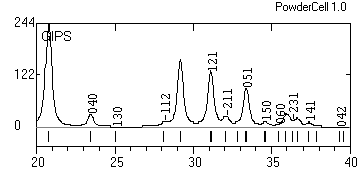

 |
The Diffraction Pattern |  |
 The main topic of PowderCell is the calculation of the diffraction pattern. Since the aim of the program is the structure modelling by the refinement of powder pattern, the reliability of the created model is dependent on the diffraction simulation, directly. Therefore we maked a point of it.
The main topic of PowderCell is the calculation of the diffraction pattern. Since the aim of the program is the structure modelling by the refinement of powder pattern, the reliability of the created model is dependent on the diffraction simulation, directly. Therefore we maked a point of it.
This is the reason for the relative keen trouble regarding the graphical output, too. PowderCell is able to export the diffractograms as Windows Metafile, as bitmap or using the clip board (this corresponds to the Metafile export). The shown picture is the result of copy by clip board. If you print directly the resolution is much better than this screen here is able to demonstrate. In contrast to the DOS version, where a short description has been given at the top of the output, we abstained from a detailed caption. The reason is, that PowderCell now is able to output the powder pattern for up to ten different structures and therefore it is impossible to include all these data in a caption of the figure.

Please notice, that the import of a single experimental diffractogram is possible and, of course, necessary if one intend to compare it with a simulated pattern. For the evaluation of the coincidence between simulation and experiment a difference plot can be displayed and so-called R-values may be faded in.
PowderCell offers a series of arrangement tools for the powder pattern representation. Thus, not only the sum of the intensity curves of all considered phases can be faded in, but also the single curves. A user-friendly zooming by the mouse pointer has been produced, but also the shown arrows in the tool bar can be used to adapt the outfit of the diffractogram as requested. Additionally, the description of the reflections can be varied between Bragg angles, d-values, Laue indexes, hexagonal indexing, structure amplitude, integral intensity and intensity of the curve on the Bragg position.
Federal Institute for Materials Research and Testing
Unter den Eichen 87, D-12205 Berlin,
Germany